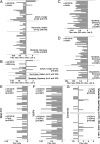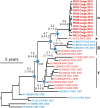Robustness against serum neutralization of a poliovirus type 1 from a lethal epidemic of poliomyelitis in the Republic of Congo in 2010
- PMID: 25136105
- PMCID: PMC4156724
- DOI: 10.1073/pnas.1323502111
Robustness against serum neutralization of a poliovirus type 1 from a lethal epidemic of poliomyelitis in the Republic of Congo in 2010
Abstract
In 2010, a large outbreak of poliomyelitis with unusual 47% lethality occurred in Pointe Noire, Republic of Congo. Vaccine-mediated immunity against the outbreak virus was never investigated. A wild poliovirus 1 (WPV1) isolated from a fatal case (termed PV1-RC2010) showed a previously unknown combination of amino acid exchanges in critical antigenic site 2 (AgS2, VP1 capsid protein positions 221SAAL → 221PADL). These exchanges were also detected in an additional 11 WPV1 strains from fatal cases. PV1-RC2010 escaped neutralization by three different mAbs relevant for AgS2. Virus neutralization was tested in sera from fatal cases, who died before supplementary immunization (n = 24), Gabonese recipients of recent oral polio vaccination (n = 12), routinely vaccinated German medical students (n = 34), and German outpatients tested for antipoliovirus immunity (n = 17) on Vero, human rhabdomyosarcoma, and human epidermoid carcinoma 2 cells. Fatal poliomyelitis cases gave laboratory evidence of previous trivalent vaccination. Neutralizing antibody titers against PV1-RC2010 were significantly lower than those against the vaccine strain Sabin-1, two genetically distinct WPV1s isolated in 1965 and 2010 and two genetically distinct vaccine-derived PV strains. Of German vaccinees tested according to World Health Organization protocols, 15-29% were unprotected according to their neutralization titers (<1:8 serum dilution), even though all were protected against Sabin-1. Phylogenetic analysis of the WPV1 outbreak strains suggested a recent introduction of virus progenitors from Asia with formation of separate Angolan and Congolese lineages. Only the latter carried both critical AgS2 mutations. Antigenetically variant PVs may become relevant during the final phase of poliomyelitis eradication in populations with predominantly vaccine-derived immunity. Sustained vaccination coverage and clinical and environmental surveillance will be necessary.
Conflict of interest statement
The authors declare no conflict of interest.
Figures




Similar articles
-
Neurovirulent vaccine-derived polioviruses in sewage from highly immune populations.PLoS One. 2006 Dec 20;1(1):e69. doi: 10.1371/journal.pone.0000069. PLoS One. 2006. PMID: 17183700 Free PMC article.
-
Genetic analysis and characterization of wild poliovirus type 1 during sustained transmission in a population with >95% vaccine coverage, Israel 2013.Clin Infect Dis. 2015 Apr 1;60(7):1057-64. doi: 10.1093/cid/ciu1136. Epub 2014 Dec 30. Clin Infect Dis. 2015. PMID: 25550350
-
Characterization of a recombinant type 3/type 2 poliovirus isolated from a healthy vaccinee and containing a chimeric capsid protein VP1.J Gen Virol. 2003 Mar;84(Pt 3):573-580. doi: 10.1099/vir.0.18708-0. J Gen Virol. 2003. PMID: 12604808
-
Genomic modifications in Sabin vaccine strains isolated from vaccination-associated cases, healthy contacts and healthy vaccinees.Acta Virol. 1996 Jun;40(3):157-70. Acta Virol. 1996. PMID: 8891097 Review.
-
Risks associated with the use of live-attenuated vaccine poliovirus strains and the strategies for control and eradication of paralytic poliomyelitis.Expert Rev Vaccines. 2012 May;11(5):609-28. doi: 10.1586/erv.12.28. Expert Rev Vaccines. 2012. PMID: 22827246 Review.
Cited by
-
High-throughput analysis of anti-poliovirus neutralization antibody titre in human serum by the pseudovirus neutralization test.Sci Rep. 2022 Sep 27;12(1):16074. doi: 10.1038/s41598-022-20544-6. Sci Rep. 2022. PMID: 36167892 Free PMC article.
-
Models to predict the public health impact of vaccine resistance: A systematic review.Vaccine. 2019 Aug 14;37(35):4886-4895. doi: 10.1016/j.vaccine.2019.07.013. Epub 2019 Jul 12. Vaccine. 2019. PMID: 31307874 Free PMC article.
-
Effect of HIV-exposure and timing of anti-retroviral treatment on immunogenicity of trivalent live-attenuated polio vaccine in infants.PLoS One. 2019 Apr 19;14(4):e0215079. doi: 10.1371/journal.pone.0215079. eCollection 2019. PLoS One. 2019. PMID: 31002702 Free PMC article.
-
Strain-dependent neutralization reveals antigenic variation of human parechovirus 3.Sci Rep. 2017 Sep 21;7(1):12075. doi: 10.1038/s41598-017-12458-5. Sci Rep. 2017. PMID: 28935894 Free PMC article.
-
Deconvolving mutational patterns of poliovirus outbreaks reveals its intrinsic fitness landscape.Nat Commun. 2020 Jan 17;11(1):377. doi: 10.1038/s41467-019-14174-2. Nat Commun. 2020. PMID: 31953427 Free PMC article.
References
-
- Centers for Disease Control and Prevention (CDC) Progress toward interrupting wild poliovirus circulation in countries with reestablished transmission—Africa, 2009-2010. MMWR Morb Mortal Wkly Rep. 2011;60(10):306–311. - PubMed
-
- Patriarca PA. Research and development and the polio eradication initiative: Too much, too soon...too little, too late? Clin Infect Dis. 2012;55(10):1307–1311. - PubMed
-
- The Global Polio Eradication Initiative (2014) Wild Poliovirus (WPV) cases. Available at www.polioeradication.org/Dataandmonitoring/Poliothisweek.aspx. Accessed May 21, 2014.
Publication types
MeSH terms
Substances
Associated data
- Actions
- Actions
- Actions
- Actions
- Actions
- Actions
- Actions
- Actions
- Actions
- Actions
- Actions
- Actions
- Actions
LinkOut - more resources
Full Text Sources
Other Literature Sources
Medical
Research Materials

